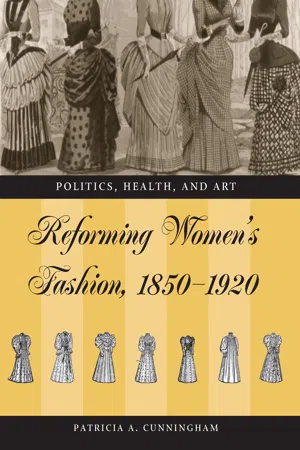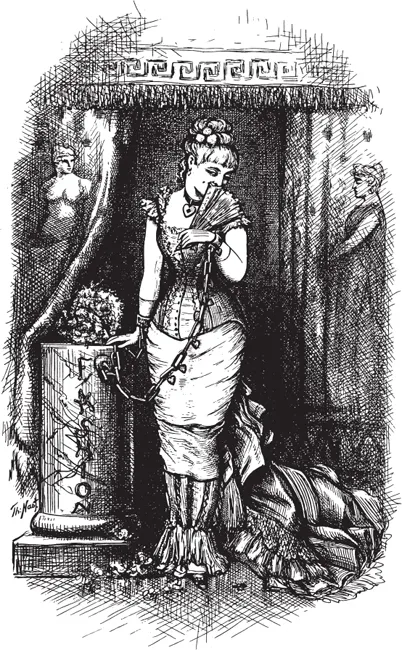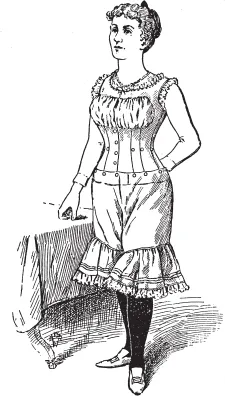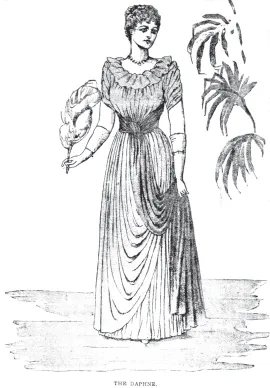
This is a test
- 250 pages
- English
- ePUB (mobile friendly)
- Available on iOS & Android
eBook - ePub
Book details
Book preview
Table of contents
Citations
About This Book
The first comprehensive study of women's dress reform
During the latter half of the nineteenth and the first decade of the twentieth centuries, books, periodicals, and newspapers were rich in discussions related to women's roles, health, beauty, and dress. Many believed that restrictive and unwieldy women's fashions compromised health, distorted women's true physical beauty, and curtailed the potential role of women in society. Reforming Women's Fashion, 1850-1920 focuses on the efforts toward reforming women's dress that took place in Europe and America during this period and the types of garments adopted by women to overcome the challenges posed by fashionable dress.
Frequently asked questions
At the moment all of our mobile-responsive ePub books are available to download via the app. Most of our PDFs are also available to download and we're working on making the final remaining ones downloadable now. Learn more here.
Both plans give you full access to the library and all of Perlego’s features. The only differences are the price and subscription period: With the annual plan you’ll save around 30% compared to 12 months on the monthly plan.
We are an online textbook subscription service, where you can get access to an entire online library for less than the price of a single book per month. With over 1 million books across 1000+ topics, we’ve got you covered! Learn more here.
Look out for the read-aloud symbol on your next book to see if you can listen to it. The read-aloud tool reads text aloud for you, highlighting the text as it is being read. You can pause it, speed it up and slow it down. Learn more here.
Yes, you can access Reforming Women's Fashion, 1850-1920 by Patricia A. Cunningham in PDF and/or ePUB format, as well as other popular books in History & World History. We have over one million books available in our catalogue for you to explore.
Information
CHAPTER ONE |
Introduction
Fashion, Health, and Beauty
Strive as you will to elevate woman, nevertheless the disabilities and degradation of her dress, together with that large group of false views of the uses of her being and of her relations to man, symbolized and perpetuated by her dress, will make your striving vain.
—Gerrit Smith
Throughout the nineteenth century and in the early decades of the twentieth century in Europe and America the basic silhouette of women’s dress went through many permutations, from tubular to full-skirted and back to tubular. Emphasis could shift from the breast, shoulders, waist, and derrière and then back again. The intended shape or style of dress and accompanying silhouette were dependent not on the natural shape of each individual but rather on various undergarments—corsets, petticoats, crinolines, bustles, and other supporting devices that helped to create the fashionable look. Many people viewed changes in clothing styles a natural phenomenon of an advanced society and thus believed that new fashions were an inevitable outward expression of progressive social values, control, and hierarchy; fashion was a sign of modernity. Growing numbers of individuals, however, began to believe that women’s clothing, particularly fashionable dress, was harmful to their health. For these people fashion signified and was a major cause of women’s political and economic oppression. Because clothing often encompassed artificial forms, some reformers also argued that fashionable dress was aesthetically unpleasing as well.
In the second half of the nineteenth century and early twentieth century it was no longer enough to look modern by adopting the latest fashion; many women now wanted to be modern. These women desired simple, healthful, practical clothing that would allow them to be active participants in the public, professional, and economic arenas of society, but fashion and its accompanying rules for behavior were tenacious. Women’s minds continued to be forcefully affected by fashion. Changing the course of fashion and the prescribed behavior that seemed so closely linked to it would prove no simple task. Fashion was so pervasive in women’s lives that cartoonists frequently depicted women as “slaves to fashion” (Fig. 1).

Fig. 1 Harper’s Weekly proof etching by Thomas Nast, c. 1880. It is not known if this illustration was published.
Since the time of Louis XIV, what was in fashion and what was to become the fashion, whether in dress, architecture, furniture, and indeed in all of the decorative arts, usually emanated from Paris. It is, therefore, not surprising that the art of high fashion, haute couture, had its beginnings in Paris. In the mid-nineteenth century fashion decisions became largely the province of English-born Parisian couturier Charles Frederick Worth and a coterie of like-minded producers of fine, hand-made gowns and accessories in Paris. By the turn of the twentieth century, the House of Worth and other purveyors of French haute couture were well established as the arbiters of taste in dress. While there were, of course, high-fashion designers of women’s clothing throughout Europe and America, these specialists often adapted the new Paris styles. This pattern of copying the dictates of Paris continues to this day, although to a lesser degree. Dissemination of French fashion occurred through the channels of fashion periodicals and general women’s magazines, which offered illustrations and, in some cases, patterns of the latest styles. Newspapers also kept the public abreast of the latest fashions worn by Parisian demimondaines, actresses, and fashion-conscious wealthy Europeans and Americans.1
Women from all levels of society followed the latest fashion, especially for clothing worn in the public sphere. Concern for the latest styles of dress was not an idle pastime, for it was socially important to be considered fashionable and beautiful; clothes could earn one merit in society. Indeed, as interpreted by Thorstein Veblen in 1899, the fashionably dressed woman was a major communicator of family status and wealth. Etiquette books and advice manuals of the time make it clear that being in fashion also meant wearing the correct clothing designated for specific occasions and time of day. It was important to adhere to these rules, for they were necessary to achieve a place in society.2
Studies in the social psychology of clothing reveal that following the latest fashion and keeping in touch with social rules are essential to feelings of belonging and fitting into society. Even today people believe that clothes signify the moral and spiritual nature of women. Clothing, therefore, remains an important aspect of an individual’s persona as well as a mediator of social relationships. Thus, while clothing has changed since the nineteenth century, some of its basic functions have not. Our understanding of current motivations regarding clothing can lend some insight into nineteenth-century patterns of behavior.3
While individuals would not necessarily wish to go against the norms of society or, worse yet, suggest that they might have questionable morals, in the nineteenth century many women did shun fashionable clothing because they believed that it harmed their health. They argued that the amount of underclothing, the sheer weight of the clothes, and the constriction of the corset were not only harmful to women’s health but detracted from women’s beauty; in fact, many believed that the clothing was ugly because it did not follow the natural form of the human body. For them, the body itself was ugly because fashion had destroyed its natural beauty.
Health and beauty were not the only issues regarding women’s dress. For no small number of people linked restrictive clothing to women’s limited roles and to what they perceived as women’s inferior political position in society. Clearly, many women in the nineteenth century could not, or chose not to, focus their lives on being fashionable. As middle-class women became more involved in the public sphere and attended college, they desired to be more active participants in roles outside of the domestic sphere. For these women being modern meant more than wearing the latest styles in dress. Indeed, in the second half of the nineteenth century increasing numbers of women were attending college and entering professions and businesses. Thus, women sought economic and political power on many fronts.4
Reform obviously was not the concern of a single group. Clothing reform was of interest to many organizations and was an international phenomenon, especially from the second half of the nineteenth century through the first decade of the twentieth century. There were many people involved in dress reform, and their persistence over a period of time attests to the continuing interest in creating alternatives to fashionable women’s dress. Promoters of women’s-clothing reform in America, Britain, and the European continent included men and women who were health or hygienic reformers, educators, feminists, physicians, artists, architects, club women, dancers, actresses, opera singers, members of communal and religious groups, and many other educated people. They all sought in some way to alter and improve contemporary styles of women’s dress.5
In order to make fashion rational, some advocates of reform suggested altering the underpinnings of women’s dress—corset, corset cover, petticoats, bustles, pads, etcetera. They wanted to keep the outer dress in compliance with the styles then in fashion so they devised ways to construct fashionable garments to be less restrictive and cumbersome. Other reformers began to advocate completely new clothing styles that would not suggest an inferior role and that would allow enough ease in movement for work and active sports. These new styles of clothing went against the norm, hence today the term “anti-fashion” often is used to describe them. As such, they were viewed as less than attractive alternatives to fashionable styles of women’s dress. Such reform garments took several forms and appeared in the streets and salons of America, in Britain, and on the Continent. They included trousers (Fig. 2), reform underwear (Fig. 3), and artistic “aesthetic” gowns. (Though its significance was not readily apparent, the new underwear was an important aspect of reform, because it allowed women to alter their dresses unobtrusively in order to “make fashion rational.”) Subsequent chapters will focus on these three types of reform garments and their arrangement. However, before engaging in a discussion of garment styles and their acceptance, I will offer insight into the nature and function of nineteenth- and early-twentieth-century women’s clothing, the inherent problems with it, and the issues of health and beauty that ultimately were responsible for attempts to alter it.6

Fig. 2 “The First Appearance,” from a print issued by Kellogg in 1851 features trousers. Courtesy Peters Collection, National Museum of History and Technology.

Fig. 3 Umbrella Drawers, one of several reform undergarments offered by the Battle Creek Sanitarium. Battle Creek Sanitarium Dress System (Battle Creek, Mich.: Sanitary and Electrical Supply Co., ca. 1890), 52.

Fig. 4 The Daphne Gown, one of many artistic dresses suggested by Annie Jenness-Miller. Jenness Miller Magazine 5 (January 1891): 348.
That so many diverse groups and individuals in so many parts of the world have apparently been interested in reforming women’s dress also raises a number of questions. While this chapter describes the perceived problems with women’s dress, in later chapters dealing with each of the three major types of reform garments, I address further questions: What were the motives and characteristics of the people who advocated the different reform styles? What arguments did they use? How were their efforts received by the public at large? How did their concerns relate to other progressive movements of the nineteenth century? In what way did their persistence impact the ultimate freedom of dress enjoyed by women in the twentieth century?7
THE HISTORICAL PRECEDENCE FOR REFORMING WOMEN’S CLOTHING
Reform ideas concerning dress were not unique to the nineteenth and twentieth centuries. There were sumptuary laws in the ancient world, which were rather ineffectual efforts to control extravagant dress. Strictures on clothing behavior also existed in Europe from the Middle Ages through the eighteenth century. These, too, were meant to restrict the extravagant display of clothing by those considered unworthy of the status their clothing might denote. In eighteenth-century England the prominent artists Sir Joshua Reynolds and William Hogarth commented that there were problems presented by fashionable dress. And indeed in that century, largely owing to the influence of the writings of Jean-Jacques Rousseau (in Émile), some effort was made to improve the clothing of children, who at the time were usually dressed as adults. Rousseau and his followers believed that children needed to be comfortable and have more freedom of movement. Children began to be dressed in simple clothing more appropriate to their specific needs.8
Likewise, it must be understood that “fashionable” women’s dress usually referred to the latest, most current styles acceptable for the public sphere or for social events or formal occasions in the privacy of the family and home. Nineteenth-century etiquette determined what was appropriate. Fashion, tempered by rules of etiquette, called for almost complete covering of the upper body during the day, but allowed women to wear decolletage for the evening. The degree of uncovering, or display, would be determined by the event, place, or time of day. Rules of etiquette also denoted appropriate dress for the home, where women could wear comfortable, loose-fitting clothing called house gowns, wrappers, morning gowns, and tea gowns designed specifically for this use. Etiquette also determined proper clothing for sports and physical activities, for which some women wore bifurcated garments—usually loose, full trousers gathered in to fall somewhere between the knee and ankle. These loose trousers worn for gymnastics, as well as the house gowns worn for comfort in the home, were not designed for public scrutiny and were therefore considered unfit to wear in public.9
Clothing for Comfort, Work, and Play
When middle- and upper-class women rose in the morning, they usually put on a loose-fitting morning gown or wrapper, what might be best defined as a house gown. If they then chose to work, they might wear the very loose type, such as the Mother Hubbard style, which became popular in the 1880s. The cut of all these garments, especially the Mother Hubbard, was very simple compared to clothing worn in public; and women might wear fewer, or perhaps looser, undergarments with them. Women could loosen the corset, or wear a soft corset. Some hou...
Table of contents
- Cover Page
- Halftitle Page
- Title Page
- Copyright Page
- Dedication
- Contents
- Preface
- Acknowledgments
- Chapter One: Introduction: Fashion, Health, and Beauty
- Chapter Two: Trousers: The Rational Alternative to Skirts
- Chapter Three: The Invisibles: Hygienic Underwear, “Dress Systems,” and Making Fashion Rational
- Chapter Four: Artistic Dress in England: Visions of Beauty and Health
- Chapter Five: Artistic Dress in America
- Chapter Six: Artistic Dress and the Modern Design Movement on the Continent
- Chapter Seven: Fashion, Dress Reform, and the New Woman
- Notes
- Bibliography
- Index